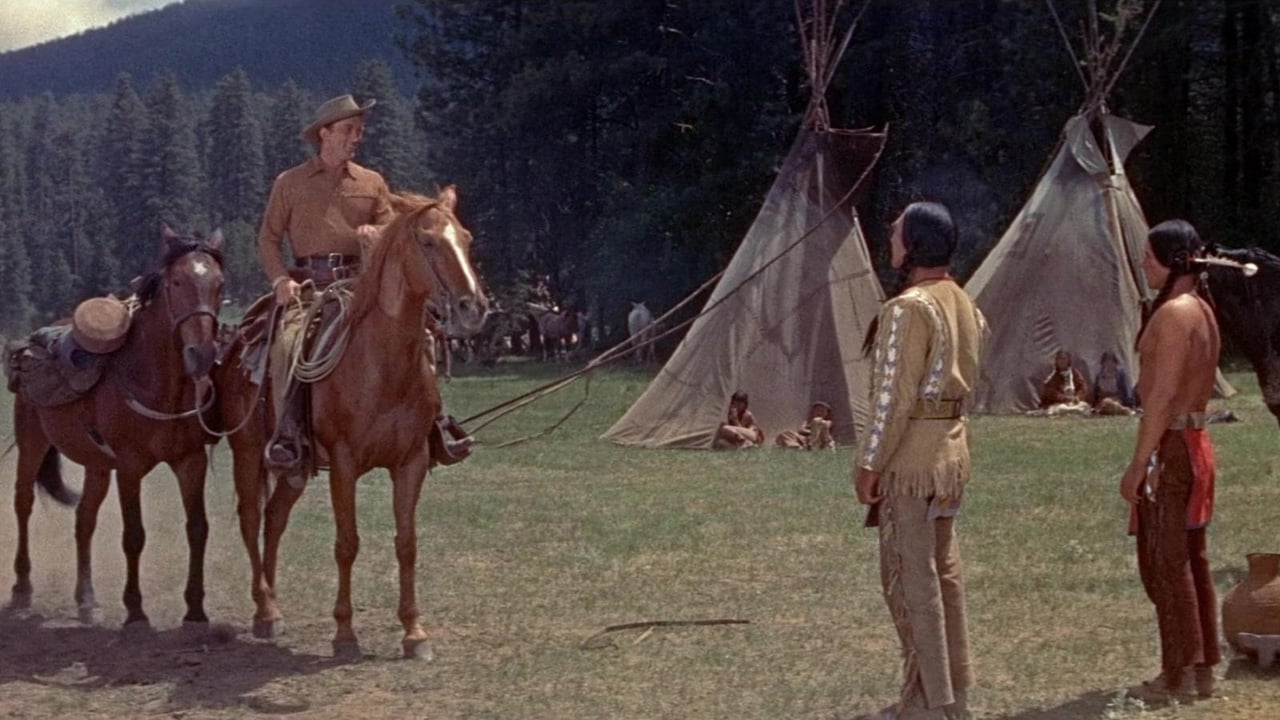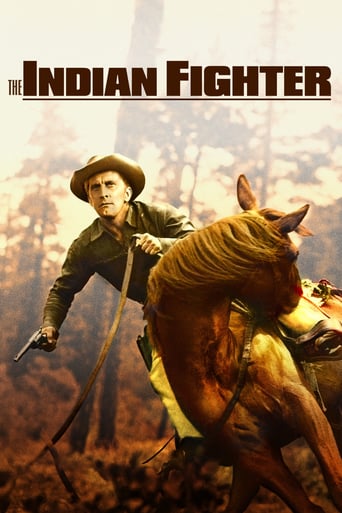

This first film released by Kirk Douglas's Bryna Production Co. begins with luscious Italian actress Elsa Martinelli(Onahti) slipping out of her clothes in a forest, and taking a bath in a river. Kirk Douglas comes moseying along on a horse, takes a peek, and continues on. But, he'll make his acquaintance more forcefully in the future, always when she is alone and near or in the river. They will end the film floating together in the river. In between these sensual interludes, which are what most people most remember about this film, is more traditional frontier western fare, including bad white men, who want to steal the Indians' gold mine, a bad Indian, who's willing to tell them where the mine is for a jug of whiskey, and a bad wagon train guide who leads the train into the heart of Sioux territory just to have a tryst with the chief's daughter. The later is, of course, Kirk Douglas, as Johnny Hawks. In his absence from the wagoners, bad things happen, which might have been averted if he had been present. These launch a full scale military response by the Sioux, and a panicked retreat of the wagoners to the fort from wince they came. Shirking his duty, even for a few hours of pleasure, made him partly responsible for the travesties that occurred in his absence, and made him vulnerable to the charge of being an Indian lover, rather than an Indian fighter. After all, he usually verbally minimized the chance of a seemingly unprovoked Indian attack, saying that he liked Indians and white folks equally well, and saw no reason why they couldn't get along peacefully(I'm afraid he was a little overoptimistic in this regard). Thus, Johnny Hanks had to redeem himself in the eyes of the whites by taking a leading part in the defense of the fort and inhabitants during the all out charge of the Sioux, who unwisely staged their attack in broad daylight. In reality, Indians very rarely launched a full scale attack, even at night, against a well built fort with an adequate number of defenders. It was simply too lethal, in most cases. They were less able to absorb a large loss of life than the whites. But, such an attack, especially if accompanied by a partial burning of the fort, as in this film, was hard to resist as the climactic 'action' event. Of course, such an attack is also seen in certain other films. Hawks finally ended the battle by escaping the fort to parley with Red Cloud, trying to convince him that further bloodshed wouldn't bring back brother Gray Wolf. Also, he promised that he would bring in the assassin of Gray Wolf(Walter Matthau, as the greedy Wes Todd) to be dealt with in Indian fashion. Lon Chaney, Jr., played his partner Chivington, in the quest for gold. Chivington killed several other Indians, that added fuel to the animosity of the Sioux toward the whites.......Diana Douglas, Kirk's ex-wife, played Susan, a widow with a son. She tried to get Hawks to accompany her to Oregon, but no dice. He preferred Onahti and his accustomed lifestyle......Veteran actor Alan Hale, Jr. played a wagoner who tried to interest Susan in joining him in Oregon, citing his experience growing apples. Walter Abel played Captain Trask, of the fort, while stern-faced Edward Franz played Red Cloud........Ironically, the film was about people moving to Oregon, and was filmed entirely around Bend, Oregon, but the story takes place entirely in eastern Wyoming........I'd like to return to the Hawk-Onahti romance. When Hawks first accosted her, she struck back with a knife, which he took from her. Ignoring her water jars, she ran toward the encampment. Surprisingly, she didn't tattle on Hawks, suggesting possible interest in him. In the second, most memorable incident, again, she was initially hostile, including when he pulled her down in the river shallows and lay on top of her. But, suddenly, she smiled and stopped resisting. Later, they relaxed under a tree and talked about Hawks need to continue with the wagon train vs. his desire to be with her. Hawks' defeat of Grey Wolf, in a staged duel, may have influenced her perception of him. Next, they independently cooperated in subduing Gray Wolf-killer Todd, and bringing him in to stand Indian justice. Lastly, of course, they are floating together in the river........In all, one of the most memorable westerns you will find. See it at You Tube.
... View MoreWe are at the end of the US civil war, Johnny Hawks, a renowned Indian fighter, is at peace with the Sioux and wants to rebuild his life, even romance with the chiefs daughter is in the offering. But as the peace between the US and the Indians is being brokered, two greed driven Whiskey traders usurp everything due to their greed for Indian gold up in the hills. So just as Hawks leads a wagon train through Sioux territory on the way to Oregon, war has again been declared, with Hawks coming under suspicion of favouring the Indians.Directed by André De Toth and starring Kirk Douglas {Hawks}, Walter Matthau, Lon Chaney Jr, Elisha Cook Jr and the outrageously beautiful Elsa Martinelli, The Indian Fighter, if I may be so bold? Is vastly undervalued on certain internet sites! Just about breaking the mold of its B movie feel, it's a piece that with a little bit of intelligence from the casting department, could have been a far better picture. The American cast do fine, but in amongst this splendidly shot picture (and it is), we have to suffer none Indian actors playing excellently written Sioux Indian characters. It's such a shame because here it's a delight to see the Sioux portrayed as a complex and resourceful race, not just in dialogue exchanges, but in a quite exhilarating attack on a US Fort, the use of horses for a disguise operation, and the method of attack {hello, it's a wooden Fort} shows them to have a bit more about them than the cannon fodder they were often portrayed as in many lower grade Westerns.It's still one fine entertaining film tho!Kirk Douglas leads the way with a typically ebullient genre show that he was especially good at, a different kind of hero is given just about the right amount of credibility from Douglas, who is in turn backed up by Chaney and Matthau who appear to be revelling in playing slimy characters. André De Toth is a director who has a couple of bona fide classics on his CV, not a name that is mentioned often, but his construction of a story and his excellent staging of the action on offer here, ensures that I personally will be seeking out more of his efforts. Last but by no means least, one has to mention the delightful work from cinematographer Wilfred M. Cline, who gleams the best from the Bend, Oregon location shoot, to round out The Indian Fighter as one hugely enjoyable genre piece. 7/10
... View MoreThe Indian Fighter (1955) is a nearly forgotten western gem about the former Indian fighter Johnny Hawks (Kirk Douglas).A war breaks out between the Indians and the whites when some of them are too interested in their gold.Walter Matthau (Wes Todd) and Lon Chaney Jr. (Chivington) are two of such people.Also Hawks' interest in the Sioux Chief's daughter Onahti (Elsa Martinelli) causes some trouble.André De Toth is the director of this western movie.Kirk Douglas has some credibility in the lead.He was just the right man to play these tough guy roles and still would be if he decided to do new movies.His ex-wife Diana Douglas plays a tough woman called Susan Rogers.Walter Matthau could be the funny man and in this movie he makes a fine crook.Lon Chaney Jr. makes a perfect accomplice to Walter.I enjoyed watching this western.It entertained me from the beginning till the end.Isn't that what a good western should do?
... View More"The Indian Fighter" was filmed entirely in the outdoor beauty of Oregon. The scenery and color are breathtaking. The action scenes are expertly staged and executed, particularly the Indian attack on the fort. Kirk Douglas stars in the title role as a scout who is hired to guide a wagon train through Indian Territory to Oregon. Walter Matthau (in an early role) and Lon Chaney (wasted again) play the villains of the piece who start up an Indian war by trying to steal gold from their land. Eduard Franz plays Red Cloud the Sioux chief who tries to keep the white man from encroaching on his people's land. Elsa Martinelli is an Indian maiden who becomes Douglas' main love interest and Diana Douglas (Kirk's wife at the time and mother of MIchael) plays a settler woman with designs on Kirk but who has to settle for hard-working Alan Hale instead. I wonder how Diana Douglas felt about Kirk rolling around in a creek with Ms. Martinelli? Rounding out the cast are a number of familiar faces. Walter Abel plays the army captain, Elisha Cook a frontier photographer and Ray Teal, Frank Cady and Lane Chandler as various settlers. "The Indian Fighter" rises a step above similar westerns through its beautiful scenery and exciting action sequences. It is a truly exciting and colorful outdoor adventure.
... View More